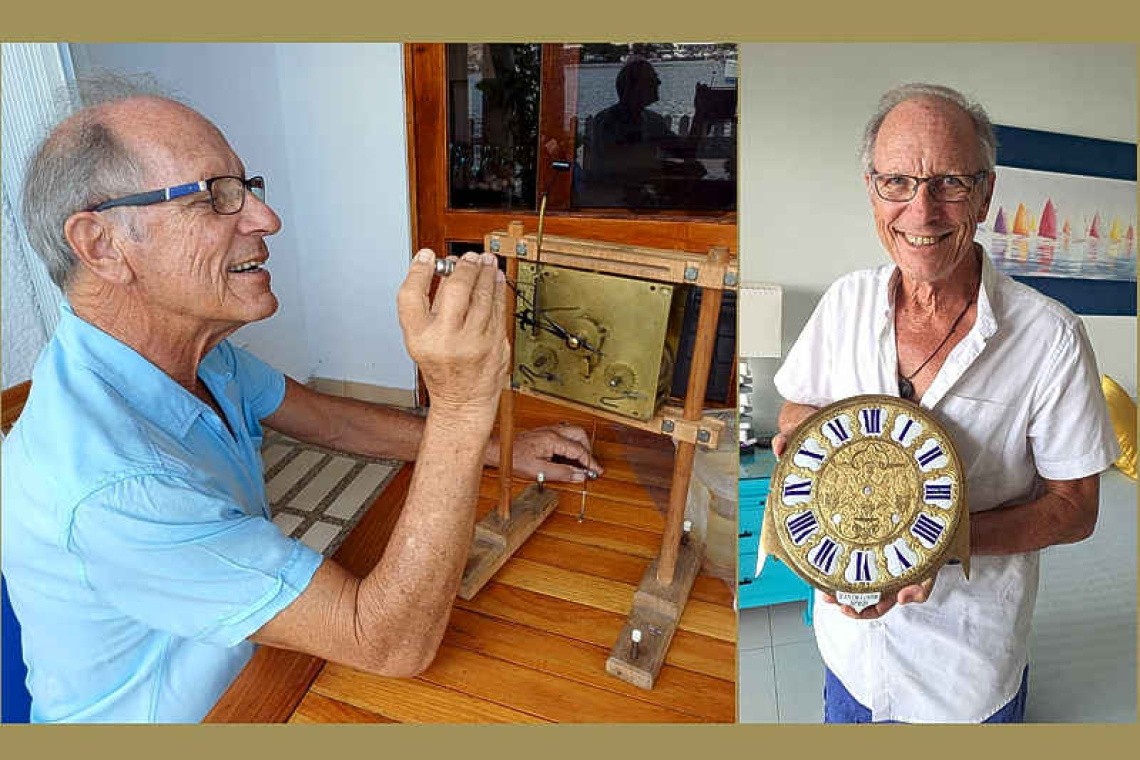By Lisa Davis-Burnett
SIMPSON BAY--Many of us have hobbies and passion projects. Mike Symonds takes it to a whole new level. His devotion to restoring antique timepieces, especially clocks, goes well beyond the realm of the hobbyist. His eyes glaze over in reverie as he explains the impact of a small discovery, a bit of history come to life through his careful attention. Mike loves the object, but more the story behind the object, imagining the skill of the craftsmen that created it and the affluent person for whom it was made.
His latest obsession is a seventeenth century cabinet clock lavishly adorned with a golden Roman Charioteer and a collection of goddesses, jesters, birds, bees, squirrels and winding flourishes of ivy and flowers.
The person for whom this treasure was made is undoubtedly the Sun King of France, Louis the XIV. His court of Versailles was well known for making such clocks, with the famed cabinet-maker Andre Charles Boulle in charge and others specializing in the enamelling of the numerals and yet others focused on the tiny springs and wheels that make the clock keep precise time. This was an era known as the Golden Age of Clock Making. Mike shared his amazement, “The quality of the movement astounds me; this was 1650 to 1720! They had no electricity, no batteries, working by candlelight, lathes had to be turned by an assistant.”
Mike’s passion for antique timepieces began as he observed and helped his father build a 19th century Congreve Clock from plans. His fascination grew, seeing how the mechanisms come together and with a smile he says, “The bug bit!” It started a journey lasting four decades so far, and still going strong.
It took a while, but Mike eventually took a class on restoration of clocks and later joined the Antiquarian Society of London. This group of specialists delve into the minutiae of life long ago, protecting artefacts that have survived from centuries past, researching to understand their significance. They hold that knowledge for the future generations to appreciate how things once were. When a museum curator is at a loss to name something in their collection, they call the Antiquarian Society.
“I’ve restored some very interesting clocks in my time,” says Mike with a grin. He is full of stories of families that held on to their beloved timepieces, against all odds. Clocks that have survived wars, and clocks that have been smuggled out of wars. Clocks that were buried in the backyard in desperation and dug up years later after the family returned.
This current clock is of such a provenance that it is hard to believe he discovered it in a warehouse on the French side of our island, “I’ve been doing this so long that I know what I’m looking at.” He notes: “I once saw a clock similar to this one, about 25 years ago, but no two are ever identical. They were made by hand, every bit. It was such an undertaking; it was the work of a lifetime.” He says it is beyond rare to find such an item outside of a very expensive collection.
“When I restore,” says Mike, “I do it sympathetically. It’s had a difficult life, this timepiece, and as I am a perfectionist, I have to get it right, 98% is not good enough for me. I prefer to restore the original materials, rather than replace parts. This clock has the original springs, but it hasn’t run for more than 40 years. The springs haven’t rusted because they were coated in oil…very old oil! I had to remove that old oil and give the springs their memory back.” But he did it and as this writer was speaking with him, he checked out the time, and indeed it was keeping correct time.
Mike is researching the symbols gilded around the cabinet, gold adornments inlaid into the wood and figures cast in bronze and then coated with gold paste in a style called ormolu. The shapes were painted with the concoction of gold and other elements as much as 60 times, until they got the look they wanted. The dominant figure is a bas relief Roman charioteer taking centre stage. A cherub sits atop the clock, and both the inside and outside of the cabinet are lavishly decorated in the rococo style with goddesses, jesters, birds and many other symbols. “The dial of this clock is not a normal dial,” remarked Mike. “They are painted with enamel and fired.”
So the next time you check your phone for the current time, spare a moment to consider Mike Symonds, smiling as he adjusts a spring or polishes a bit of detail, carrying the past into the future, with loving care.







